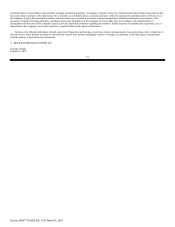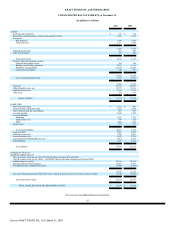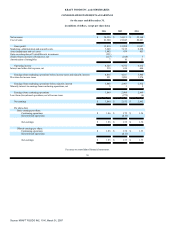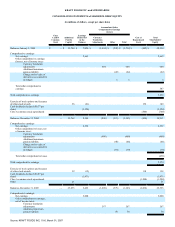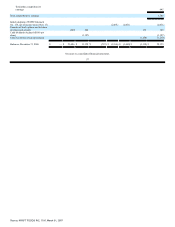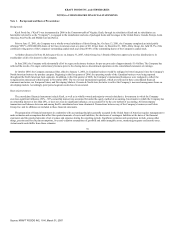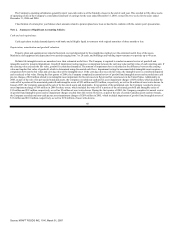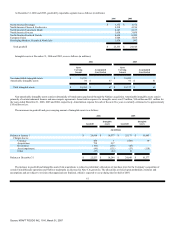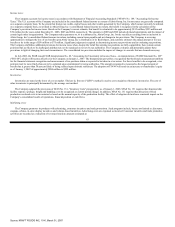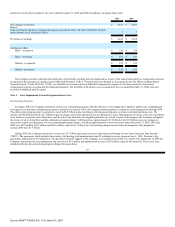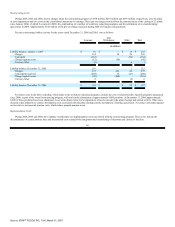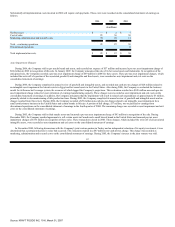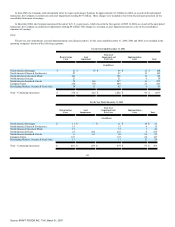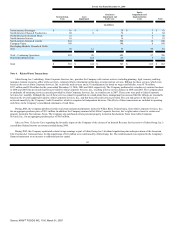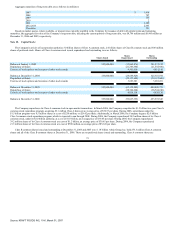Kraft 2006 Annual Report Download - page 68
Download and view the complete annual report
Please find page 68 of the 2006 Kraft annual report below. You can navigate through the pages in the report by either clicking on the pages listed below, or by using the keyword search tool below to find specific information within the annual report.
Income taxes:
The Company accounts for income taxes in accordance with Statement of Financial Accounting Standards ("SFAS") No. 109, "Accounting for Income
Taxes." The U.S. accounts of the Company are included in the consolidated federal income tax return of Altria Group, Inc. Income taxes are generally computed
on a separate company basis. To the extent that foreign tax credits, capital losses and other credits generated by the Company, which cannot currently be utilized
on a separate company basis, are utilized in Altria Group, Inc.'s consolidated federal income tax return, the benefit is recognized in the calculation of the
Company's provision for income taxes. Based on the Company's current estimate, this benefit is calculated to be approximately $195 million, $225 million and
$70 million for the years ended December 31, 2006, 2005 and 2004, respectively. The amounts in 2005 and 2006 include dividend repatriations and the impact of
certain legal entity reorganizations. The Company makes payments to, or is reimbursed by, Altria Group, Inc. for the tax effects resulting from its inclusion in
Altria Group, Inc.'s consolidated federal income tax return, including current taxes payable and net changes in tax provisions. The Company is assessing
opportunities to mitigate the loss of tax benefits upon Altria Group, Inc.'s distribution of its Kraft shares, and currently estimates the annual amount of lost tax
benefits to be in the range of $50 million to $75 million. Significant judgment is required in determining income tax provisions and in evaluating tax positions.
The Company establishes additional provisions for income taxes when, despite the belief that existing tax positions are fully supportable, there remain certain
positions that are likely to be challenged and that may not be sustained on review by tax authorities. The Company evaluates and potentially adjusts these
provisions in light of changing facts and circumstances. The consolidated tax provision includes the impact of changes to accruals that are deemed necessary.
In July 2006, the FASB issued FASB Interpretation No. 48, "Accounting for Uncertainty in Income Taxes—an interpretation of FASB Statement No. 109"
("FIN 48"), which will become effective for the Company on January 1, 2007. The Interpretation prescribes a recognition threshold and a measurement attribute
for the financial statement recognition and measurement of tax positions taken or expected to be taken in a tax return. For those benefits to be recognized, a tax
position must be more-likely-than-not to be sustained upon examination by taxing authorities. The amount recognized is measured as the largest amount of
benefit that is greater than 50 percent likely of being realized upon ultimate settlement. The adoption of FIN 48 will result in an increase to shareholders' equity
as of January 1, 2007 of approximately $200 million to $225 million.
Inventories:
Inventories are stated at the lower of cost or market. The last-in, first-out ("LIFO") method is used to cost a majority of domestic inventories. The cost of
other inventories is principally determined by the average cost method.
The Company adopted the provisions of SFAS No. 151, "Inventory Costs" prospectively as of January 1, 2006. SFAS No. 151 requires that abnormal idle
facility expense, spoilage, freight and handling costs be recognized as current-period charges. In addition, SFAS No. 151 requires that allocation of fixed
production overhead costs to inventories be based on the normal capacity of the production facility. The effect of adoption did not have a material impact on the
Company's consolidated results of operations, financial position or cash flows.
Marketing costs:
The Company promotes its products with advertising, consumer incentives and trade promotions. Such programs include, but are not limited to, discounts,
coupons, rebates, in-store display incentives and volume-based incentives. Advertising costs are expensed as incurred. Consumer incentive and trade promotion
activities are recorded as a reduction of revenues based on amounts estimated as
63
Source: KRAFT FOODS INC, 10-K, March 01, 2007


